Pilot Low-Cost Concentrating Solar Power Systems Deployment in Sub-Saharan Africa: A Case Study of Implementation Challenges
Abstract
1. Introduction
2. Background to CSP Technologies
- Parabolic trough (PT): The parabolic trough concentrator system consists of several curved parallel mirrors that concentrate the Sun’s rays on a receiver tube containing the heat transfer fluid [15]. The PT device has six main components that include surface reflecting, absorber, support structure, electricity generation unit, thermal storage unit, and tracking system. The tracking system tracks the Sun over the day along the central axis as the Sun moves east to west [16]. The tracking system can be designed for tracking the Sun by using photosensors on the PT concentrators or astronomical algorithms installed in the tracking system.
- Linear Fresnel reflector (LFR): The LFR utilizes flat-shaped Fresnel reflectors to concentrate the Sun’s light on the receiver (linear absorbers) away from the system of reflection [17]. The LFR system also uses a single-axis tracking system to position the reflectors from east to west along a north–south axis to track the light.
- The point focusing systems: These systems concentrate the solar radiation at a central point called the receiver/tower. Examples include the solar dish (SD) system that uses parabolic dish-shaped solar concentrators that focus the sunlight onto a single central receiver [1].
3. State of the art of CSP Research and Development in Africa
4. Review of Tracking Systems for CRS
5. Discussion
- Aiming errors: These errors are related to constant aberrations including pedestal tilt due to displacement of the center of gravity, bad reference, or structure deformations due to wind loads and solar radiation refraction.
- Tracking offset errors: These errors are related to the tracking system’s movement, the resolution of the movement, and the controller’s accuracy.
- Optical errors that can be attributed to astigmatic aberration.
6. Conclusion and Recommendation
Author Contributions
Funding
Conflicts of Interest
References
- Nitz, P.; Fluri, T.; Lude, S.; Meyer, R.; Alasis, E.; Tawalbeh, M.; Shahin, W. On the Way to the First CSP Pilot Plant in Jordan: The WECSP Project. Energy Procedia 2015, 69, 1652–1659. [Google Scholar] [CrossRef]
- Kassai, M. Experimental investigation of carbon dioxide cross-contamination in sorption energy recovery wheel in ventilation system. Build. Serv. Eng. Res. Technol. 2018, 39, 463–474. [Google Scholar] [CrossRef]
- Martins, F.; Felgueiras, C.; Smitkova, M.; Caetano, N. Analysis of fossil fuel energy consumption and environmental impacts in european countries. Energies 2019, 12, 964. [Google Scholar] [CrossRef]
- World Bank. The Word Bank—Annual Report 2017; World Bank: Washington, DC, USA, 2017. [Google Scholar]
- Jan Corfee-Morlot, F.A.; Parks, P.; Ogunleye, J. Achieving Clean Energy Access in Sub-Saharan Africa a Case Study for the OECD, UN Environment, World Bank Project: Financing Climate Futures: Rethinking Infrastructure; World Bank: Washington, DC, USA, 2018. [Google Scholar]
- Ogunmodimu, O.; Okoroigwe, E.C. Concentrating solar power technologies for solar thermal grid electricity in Nigeria: A review. Renew. Sustain. Energy Rev. 2018, 90, 104–119. [Google Scholar] [CrossRef]
- Seshie, Y.M.; Tsoukpoe, K.E.N.; Neveu, P.; Coulibaly, Y. Small scale concentrating solar plants for rural electri fi cation. Renew. Sustain. Energy Rev. 2018, 90, 195–209. [Google Scholar] [CrossRef]
- Irena, W.D.I. UNSD, WB, WHO Tracking SDG 7: The Energy Progress Report 2019; UNSD, WB, WHO: Geneva, Switzerland, 2019. [Google Scholar]
- Xu, M.; Zhu, X. Simulation and Control of Heliostat Sun-tracking in Central Receiver Solar Power Plant. In Proceedings of the 2018 37th Chinese Control Conference, Wuhan, China, 25–27 July 2018; Volume 2, pp. 7553–7557. [Google Scholar]
- Pfahl, A.; Coventry, J.; Röger, M.; Wolfertstetter, F.; Vásquez-Arango, J.F.; Gross, F.; Arjomandi, M.; Schwarzbzl, P.; Geiger, M.; Liedke, P. Progress in heliostat development. Sol. Energy 2017, 152, 3–37. [Google Scholar] [CrossRef]
- Abdollahpour, M.; Golzarian, M.R.; Rohani, A.; Zarchi, H.A. Development of a machine vision dual-axis solar tracking system. Sol. Energy 2018, 169, 136–143. [Google Scholar] [CrossRef]
- Islam, R.; Bhuiyan, A.B.M.N.; Ullah, M.W. An Overview of Concentrated Solar Power (CSP)Technologies and its Opportunities in Bangladesh. In Proceedings of the 2017 International Conference on Electrical, Computer and Communication Engineering, Cox’s Bazar, Bangladesh, 16–18 February 2017; pp. 844–849. [Google Scholar]
- Zhu, G.; Libby, C. Review and future perspective of central receiver design and performance. In AIP Conference Proceedings; AIP Publishing LLC: Melville, NY, USA, 2017; Volume 1850. [Google Scholar]
- Viebahn, P.; Lechon, Y.; Trieb, F. The potential role of concentrated solar power (CSP) in Africa and Europe—A dynamic assessment of technology development, cost development and life cycle inventories until 2050. Energy Policy 2011, 39, 4420–4430. [Google Scholar] [CrossRef]
- Masood, R.; Gilani, S.I.U.H.; Al-Kayiem, H.H. A simplified design procedure of parabolic trough solar field for industrial heating applications. ARPN J. Eng. Appl. Sci. 2016, 11, 13065–13071. [Google Scholar]
- Ravelli, S.; Franchini, G.; Perdichizzi, A.; Rinaldi, S.; Valcarenghi, V.E. Modeling of Direct Steam Generation in Concentrating Solar Power Plants. Energy Procedia 2016, 101, 464–471. [Google Scholar] [CrossRef]
- Meligy, R.; Rady, M.; el Samahy, A.; Mohamed, W.; Paredes, F.; Montagnino, F. Simulation and control of linear Fresnel reflector solar plant. Int. J. Renew. Energy Res. 2019, 9, 804–818. [Google Scholar]
- Malan, K.; Gauche, P. Model based open-loop correction of heliostat tracking errors. Energy Procedia 2013, 49, 7. [Google Scholar] [CrossRef]
- Stein, K.L.W. Concentrating Solar Power Technology: Principles, Developments and Applications; Woodhead Publishing Limited: Cambridge, UK, 2012. [Google Scholar]
- Sonawane, P.D.; Raja, V.K.B. An overview of concentrated solar energy and its applications. Int. J. Ambient. Energy 2018, 39, 898–903. [Google Scholar] [CrossRef]
- Leiva-Illanes, R.; Escobar, R.; Cardemil, J.M.; Alarcón-Padilla, D.C.; Uche, J.; Martínez, A. Exergy cost assessment of CSP driven multi-generation schemes: Integrating seawater desalination, refrigeration, and process heat plants. Energy Convers. Manag. 2019, 179, 249–269. [Google Scholar] [CrossRef]
- N’Tsoukpoe, K.E.; Azoumah, K.Y.; Ramde, E.; Fiagbe, A.K.Y.; Neveu, P.; Py, X.; Gaye, M.; Jourdan, A. Integrated design and construction of a micro-central tower power plant. Energy Sustain. Dev. 2016, 31, 1–13. [Google Scholar] [CrossRef]
- Balghouthi, M.; Trabelsi, S.E.; Amara, M.B.; Ali, A.B.H.; Guizani, A. Potential of concentrating solar power (CSP) technology in Tunisia and the possibility of interconnection with Europe. Renew. Sustain. Energy Rev. 2016, 56, 1227–1248. [Google Scholar] [CrossRef]
- Zlatanov, H.; Weinrebe, G. CSP and PV solar tracker optimization tool. Energy Procedia 2014, 49, 1603–1611. [Google Scholar] [CrossRef]
- Aly, A.; Bernardos, A.; Fernandez-Peruchena, C.M.; Jensen, S.S.; Pedersen, A.B. Is Concentrated Solar Power (CSP) a feasible option for Sub-Saharan Africa? Investigating the techno-economic feasibility of CSP in Tanzania. Renew. Energy 2019, 135, 1224–1240. [Google Scholar] [CrossRef]
- Belgasim, B.; Aldali, Y.; Abdunnabi, M.J.R.; Hashem, G.; Hossin, K. The potential of concentrating solar power (CSP) for electricity generation in Libya. Renew. Sustain. Energy Rev. 2018, 90, 1–15. [Google Scholar] [CrossRef]
- Pan, C.A.; Dinter, F. Combination of PV and central receiver CSP plants for base load power generation in South Africa. Sol. Energy 2017, 146, 379–388. [Google Scholar] [CrossRef]
- Mihoub, S.; Chermiti, A.; Beltagy, H. Methodology of determining the optimum performances of future concentrating solar thermal power plants in Algeria. Energy 2017, 122, 801–810. [Google Scholar] [CrossRef]
- Bouhal, T.; Agrouaz, Y.; Kousksou, T.; Allouhi, A.; El Rhafiki, T.; Jamil, A.; Bakkas, M. Technical feasibility of a sustainable Concentrated Solar Power in Morocco through an energy analysis. Renew. Sustain. Energy Rev. 2018, 81, 1087–1095. [Google Scholar] [CrossRef]
- Elshafey, S. Solar thermal power in Egypt. In Proceedings of the 2018 IEEE Industrial Applications Society Annual Meeting, IAS 2018, Portland, OR, USA, 23–27 September 2018; pp. 1–8. [Google Scholar]
- Craig, T.; Brent, A.; Duvenhage, F.; Dinter, F. Systems approach to concentrated solar power (CSP) technology adoption in South Africa. In AIP Conference Proceedings; AIP Publishing LLC: Melville, NY, USA, 2018; Volume 2033. [Google Scholar]
- Michalsky, J.J. The astronomical almanac’s algorithm for approximate solar position (1950–2050). Sol. Energy 1988, 40, 227–235. [Google Scholar] [CrossRef]
- Zoschke, T.; Frantz, C.; Schöttl, P.; Fluri, T.; Uhlig, R. Techno-economic assessment of new material developments in central receiver solar power plants. In AIP Conference Proceedings; AIP Publishing LLC: Melville, NY, USA, 2019; Volume 2126. [Google Scholar]
- Jafrancesco, D.; Cardoso, J.P.; Mutuberria, A.; Leonardi, E.; Les, I.; Sansoni, P.; Francini, F.; Fontani, D. Optical simulation of a central receiver system: Comparison of different software tools. Renew. Sustain. Energy Rev. 2018, 94, 792–803. [Google Scholar] [CrossRef]
- Ghassoul, M. Single axis automatic tracking system based on PILOT scheme to control the solar panel to optimize solar energy extraction. Energy Rep. 2018, 4, 520–527. [Google Scholar] [CrossRef]
- Kamal, M. Microcontroller Based Single Axis Sun Tracking Control System. Int. J. Emerg. Technol. Eng. Res. 2018, 3, 3–7. [Google Scholar]
- Garcia-Gil, G.; Ramirez, J.M. Fish-eye camera and image processing for commanding a solar tracker. Energies 2019, 5, e01398. [Google Scholar] [CrossRef]
- Lee, C.Y.; Chou, P.C.; Chiang, C.M.; Lin, C.F. Sun tracking systems: A review. Sensors 2009, 9, 3875–3890. [Google Scholar] [CrossRef]
- Stone, C.W.; Lopez, K. Evaluation of the Solar One Track Alignment Methodology; American Society of Mechanical Engineers: New York, NY, USA, 1995; p. 1995. [Google Scholar]
- Sansoni, P.; Fontani, D.; Francini, F.; Jafrancesco, D.; Mercatelli, L.; Sani, E. Pointing sensors and sun tracking techniques. Int. J. Photoenergy 2011, 2011, 25. [Google Scholar]
- Hafez, A.Z.; Yousef, A.M.; Harag, N.M. Solar tracking systems: Technologies and trackers drive types—A review. Renew. Sustain. Energy Rev. 2018, 91, 754–782. [Google Scholar] [CrossRef]
- Vermaak, H.J. Techno-economic analysis of solar tracking systems in South Africa. Energy Procedia 2014, 61, 2435–2438. [Google Scholar] [CrossRef]
- Hu, Y.; Shen, H.; Yao, Y. A novel sun-tracking and target-aiming method to improve theconcentration efficiency of solar central receiver systems. Renew. Energy 2017, 120, 17. [Google Scholar]
- Camacho, E.F.; Berenguel, M. Control of solar energy systems. IFAC Proc. 2012, 8, 848–855. [Google Scholar] [CrossRef]
- Laštovi, G. Open Source Sun Tracking System with Solar Panel Monitoring and Heliostat Control System. Int. J. Contemp. Energy 2017, 3, 44–50. [Google Scholar]
- Adel, M.; Peña-Lapuente, A.; Rady, M.; Hamdy, A. Development of a New High Dynamic Range Technique for Solar Flux Analysis Using Double-CCD Optical Camera. Int. J. Renew. Energy Res. 2019, 9, 783–794. [Google Scholar]
- Pfahl, R.A.; Karsten, R.B. Method for Controlling the Alignment of A Helostat with Respect To A Receiver, Heliostat Device and Solar Power Plant. U.S. Patent 8,651,100, 18 February 2014. [Google Scholar]
- Kribus, A.; Vishnevetsky, I.; Yogev, A.; Rubinov, T. Closed loop control of heliostats. Energy 2004, 29, 905–913. [Google Scholar] [CrossRef]
- Xuemei, Z.; Xiaoling, M.; Kaizhi, L.; Wenjun, H. Precise Sun-tracking Control of Heliostats Based on a Sun’s Image Reference System. In Proceedings of the 26th Chinese Control and Decision Conference, Changsha, China, 31 May–2 June 2014; Volume 14, pp. 3–6. [Google Scholar]
- Berenguel, M.; Rubio, F.R.; Valverde, A.; Lara, P.J.; Arahal, M.R.; Camacho, E.F.; López, M. An artificial vision-based control system for automatic heliostat positioning offset correction in a central receiver solar power plant. Sol. Energy 2004, 76, 563–575. [Google Scholar] [CrossRef]
- Salgado-Plasencia, E.; Carrillo-Serrano, R.V.; Rivas-Araiza, E.A.; Toledano-Ayala, M. SCADA-Based Heliostat Control System with a Fuzzy Logic Controller for the Heliostat Orientation. Appl. Sci. 2019, 9, 20. [Google Scholar]
- Sohag, H.A.; Hasan, M.; Khatun, M.M.; Ahmad, M. An Accurate and Efficient Solar Tracking System Using Image Processing and LDR Sensor. In Proceedings of the 2015 2nd International Conference on Electrical Information and Communication Technologies, Khulna, Bangladesh, 10–12 December 2015; pp. 522–527. [Google Scholar]
- Burisch, M.; Sanchez, M.; Olarra, A.; Villasante, C. Heliostat calibration using attached cameras and artificial targets. In AIP Conference Proceedings; AIP Publishing LLC: Melville, NY, USA, 2016; Volume 1743. [Google Scholar]
- Guangyu, L.I.U.; Zhongkun, C.A.I. Heliostat attitude angle detection method based on BP neural network. In MATEC Web of Conferences; EDP Sciences: Julius, France, 2017; Volume 139. [Google Scholar]
- Carballo, J.A.; Bonilla, J.; Berenguel, M. New approach for solar tracking systems based on computer vision, low cost hardware and deep learning. Renew. Energy 2018, 133, 1158–1166. [Google Scholar] [CrossRef]
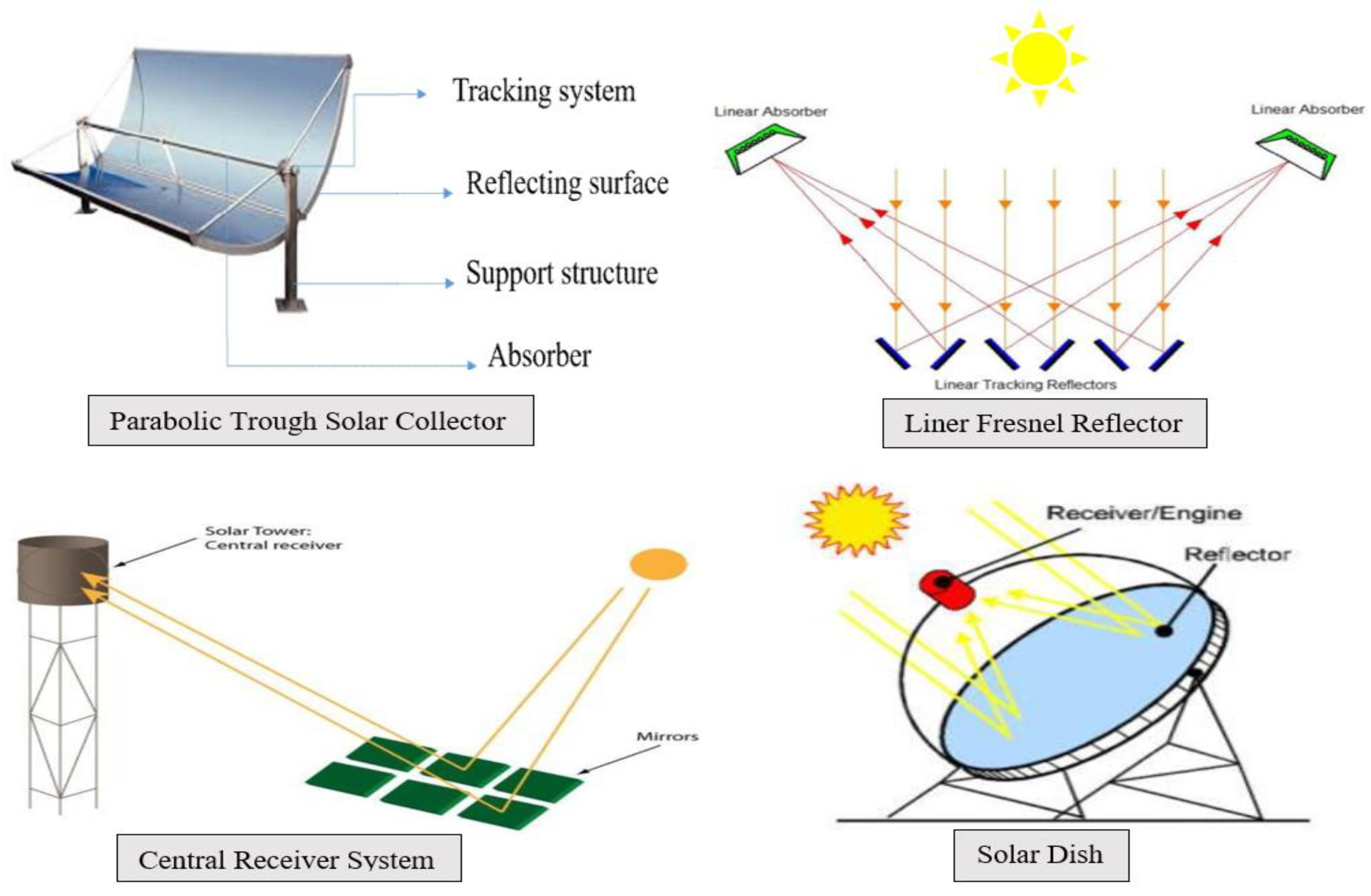
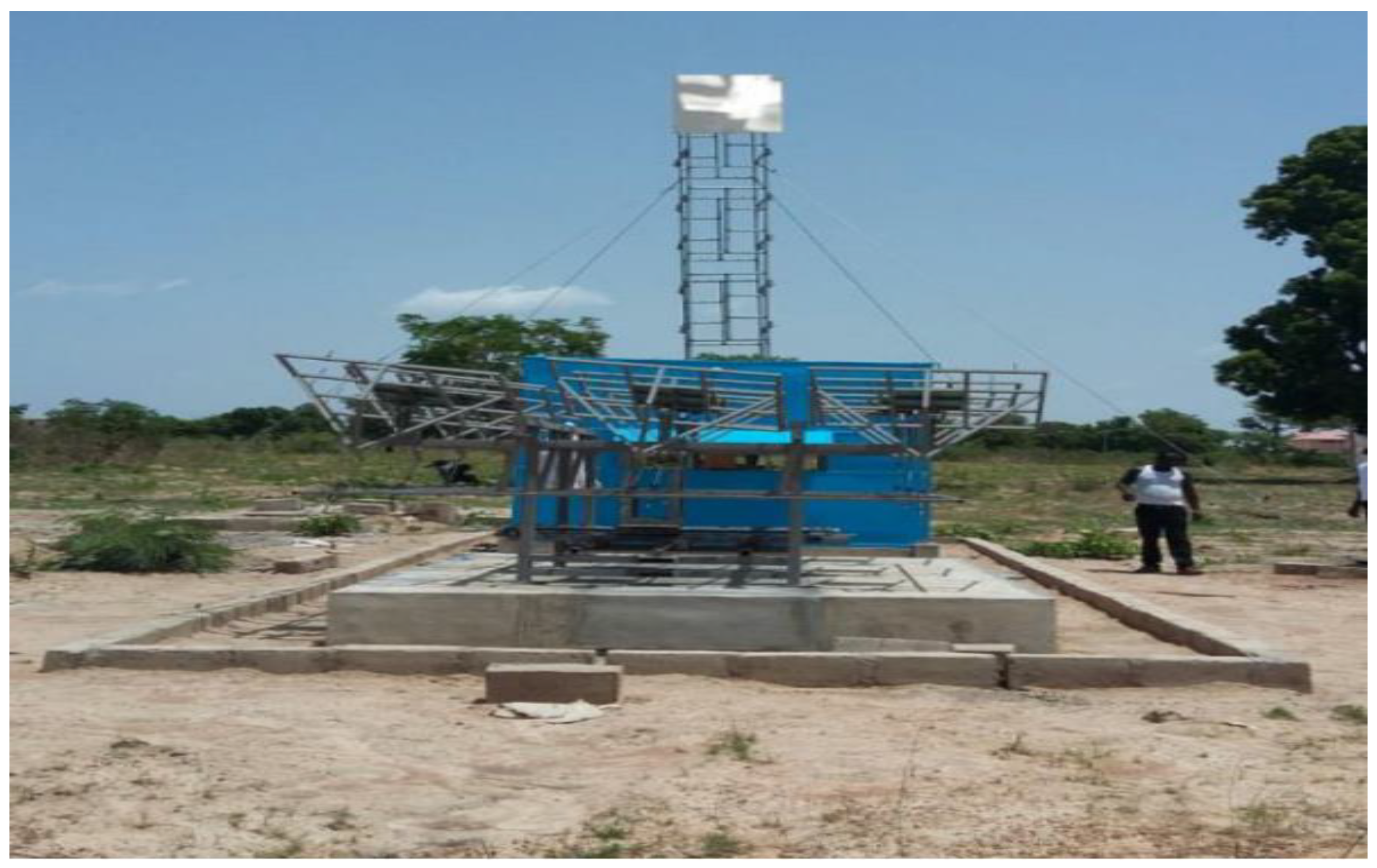
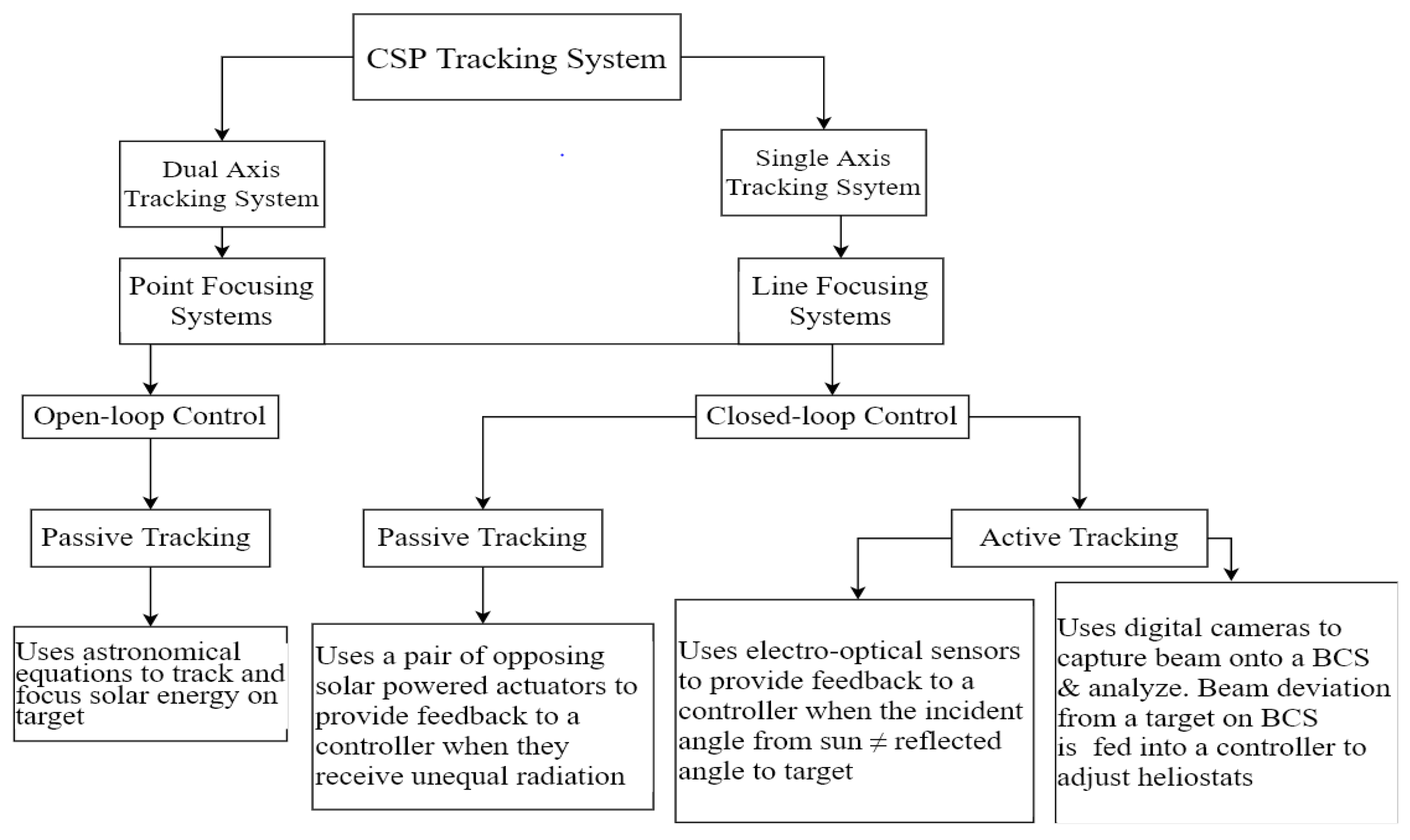
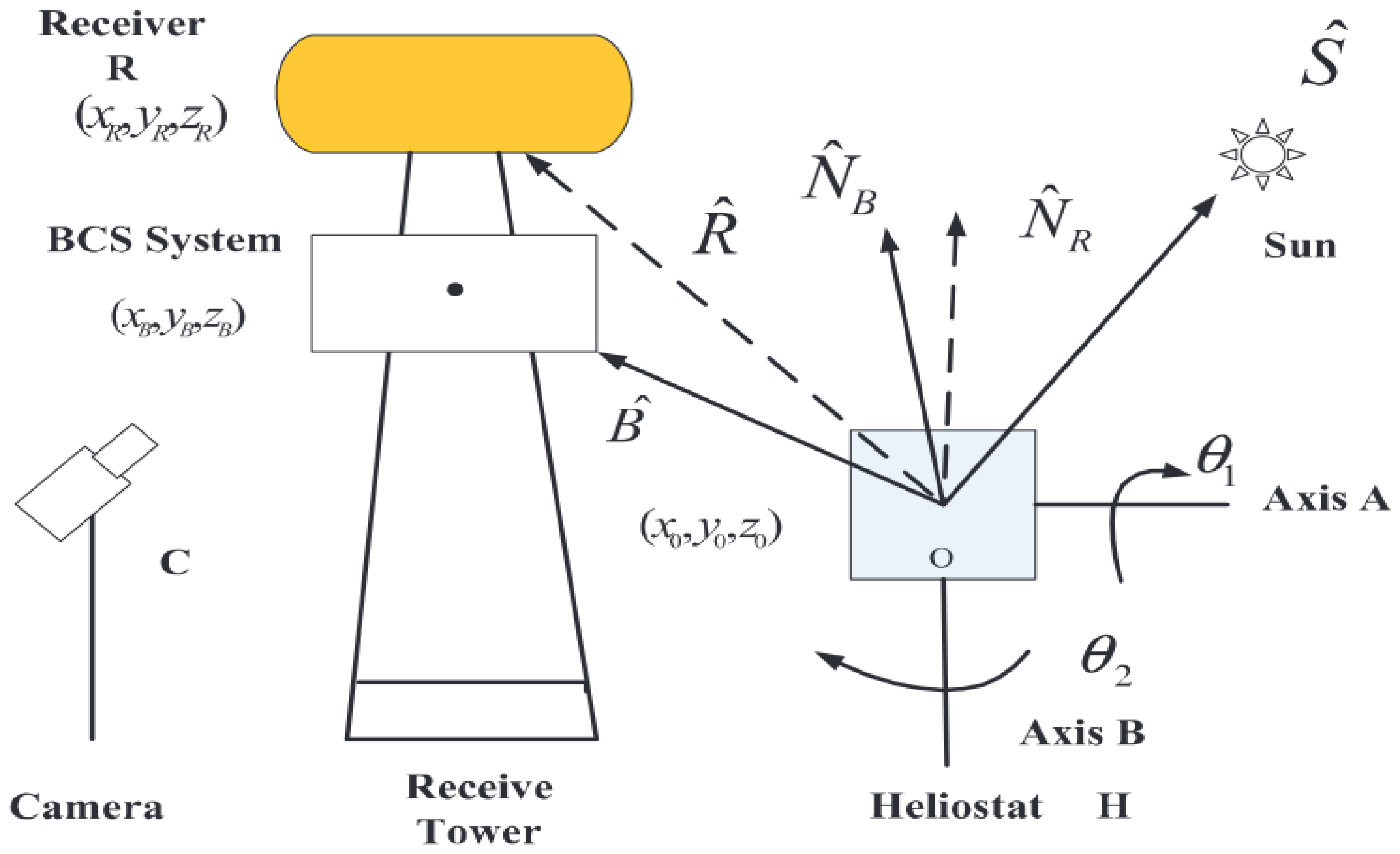
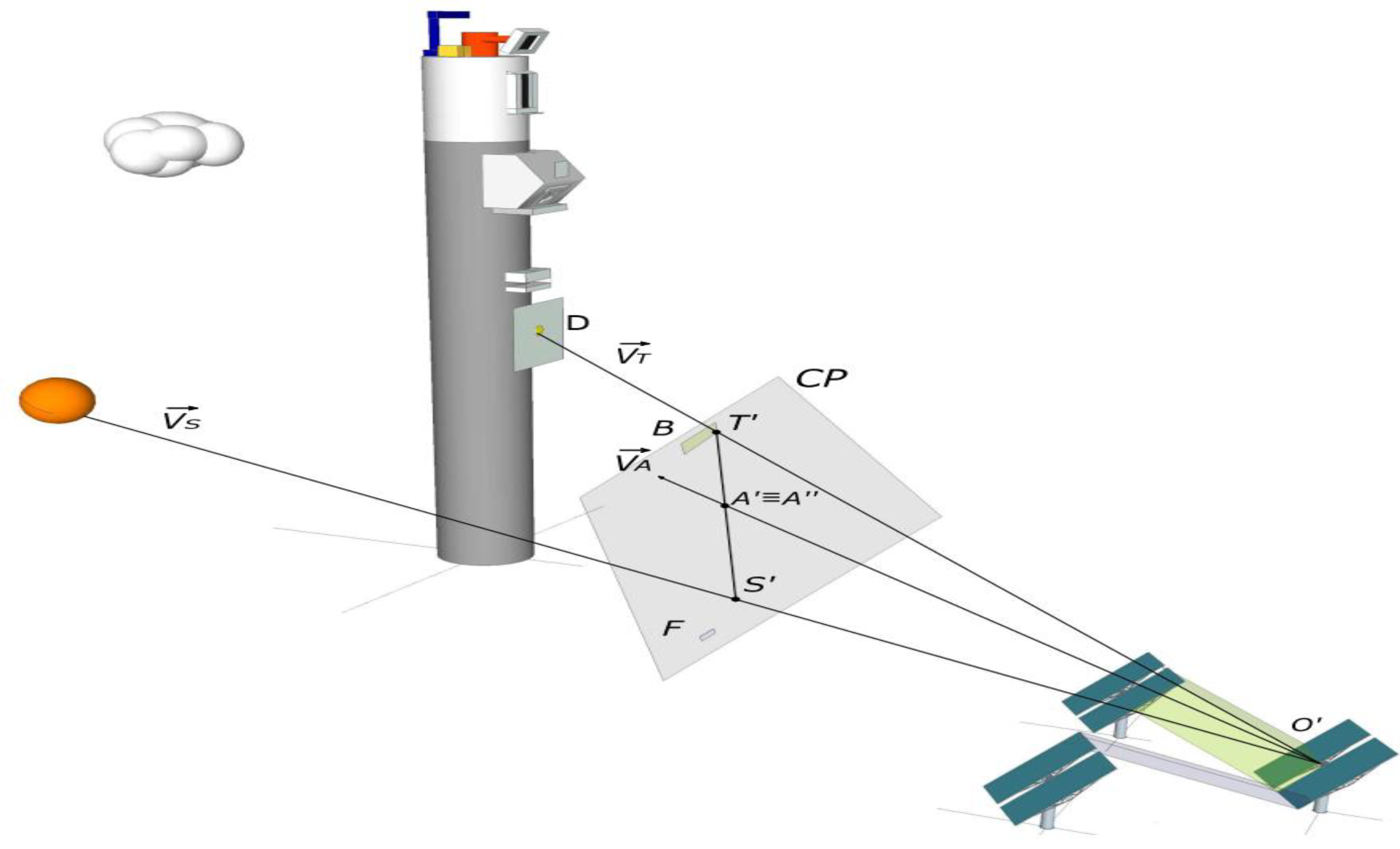
| Types of CRS Tracking Systems | Reference | Cost of Control System | Errors in Tracking System | Comment |
|---|---|---|---|---|
| Open-loop Tracking Systems | Michalsky [32] | Medium | High | Cannot verify whether reflected solar beam is accurately pointing at collector and initial small error margin accumulates into a big error margin unless the tracker is reset periodically. |
| Sensor-Based Tracking Systems | Andreas Pfahl et al. [47], Lastoviet al. [45] | Medium | Medium | Cannot eliminate astigmatism and cosine errors and errors associated with computing the three vectors to obtain the incident and reflected angles. Accuracy also depends on environmental factors, controller, and sensor resolution. |
| Machine vision-Based Tracking Systems with Camera behind the target | Kribus et al. [48] | High | High for a large number of heliostats | Computationally expensive and when several reflected images are captured, it becomes difficult to distinguish among which of the heliostats are directly focusing solar energy on the receiver and which ones should be adjusted. |
| Machine vision Based Tracking Systems with BCS below target | Zhu Xuemei et al. [49], Berenguel et al. [50], Mohamed Adel et al. [46], Guangyu and Zhongkun [54], Carballo et al. [55] | High | Medium | Computationally expensiveness, errors from beam characterization and heliostat control as well as communication delays make this tracking system less suitable. |
| Other mechanisms of CRS tracking systems | Eugenio et al. [51], Yeguang Hu et al. [43] | High | High | Requires heliostat to be closed to the target, requires a two-stage control system that needs to highly synchronize, and this decreases the accuracy of the system. The system is not suitable for a large CRS plant. |
© 2020 by the authors. Licensee MDPI, Basel, Switzerland. This article is an open access article distributed under the terms and conditions of the Creative Commons Attribution (CC BY) license (http://creativecommons.org/licenses/by/4.0/).
Share and Cite
Ramde, E.W.; Tchao, E.T.; Fiagbe, Y.A.K.; Kponyo, J.J.; Atuah, A.S. Pilot Low-Cost Concentrating Solar Power Systems Deployment in Sub-Saharan Africa: A Case Study of Implementation Challenges. Sustainability 2020, 12, 6223. https://doi.org/10.3390/su12156223
Ramde EW, Tchao ET, Fiagbe YAK, Kponyo JJ, Atuah AS. Pilot Low-Cost Concentrating Solar Power Systems Deployment in Sub-Saharan Africa: A Case Study of Implementation Challenges. Sustainability. 2020; 12(15):6223. https://doi.org/10.3390/su12156223
Chicago/Turabian StyleRamde, Emmanuel Wendsongre, Eric Tutu Tchao, Yesuenyeagbe Atsu Kwabla Fiagbe, Jerry John Kponyo, and Asakipaam Simon Atuah. 2020. "Pilot Low-Cost Concentrating Solar Power Systems Deployment in Sub-Saharan Africa: A Case Study of Implementation Challenges" Sustainability 12, no. 15: 6223. https://doi.org/10.3390/su12156223
APA StyleRamde, E. W., Tchao, E. T., Fiagbe, Y. A. K., Kponyo, J. J., & Atuah, A. S. (2020). Pilot Low-Cost Concentrating Solar Power Systems Deployment in Sub-Saharan Africa: A Case Study of Implementation Challenges. Sustainability, 12(15), 6223. https://doi.org/10.3390/su12156223






